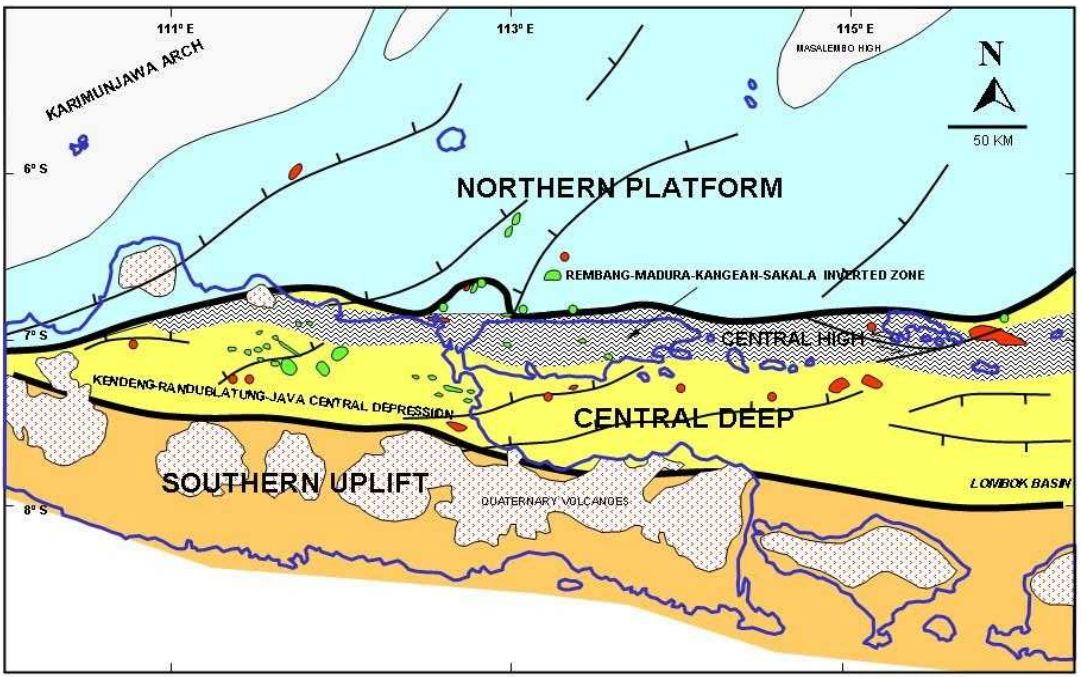Review: Geological Structure impacts to hydrocarbon potential and active faults in the East Java Basin, Indonesia
DOI:
https://doi.org/10.25299/jgeet.2024.9.3.16736Keywords:
Ophiolitic Basement, W-E Structures, Hydrocarbon, Active FaultAbstract
Review of the geological structure patterns in the East Java Basin (EJB) to understand the geodynamics has implicated to the hydrocarbon potential and active faults. However, the impact of those structures on hydrocarbon potential and active faults is unclear. This study reviewed structure patterns using surface and subsurface data, GPS, seismicity and tremors in the East Java Basin, Indonesia and Nankai Trough, Japan. In EJB, Indonesia, the tectonic setting is constrained by the Rembang Fault. The north of the Rembang Fault, the pattern exhibits NE-SW structures, while to the south, it shows W-E structures. The results indicate that the upper crust (including ophiolitic basement) has greater density to the north than to the south. Thus, vertical motion of the crust is more dominant than lateral motion to the north of the Rembang Fault. This vertical motion may trigger the reactivation of the Meratus Fault (weak zone or as active fault) located on the northern platform (e.g., the Bawean earthquake on March 22, 2023). Conversely, to the south of the Rembang Fault, there is a significant hydrocarbon potential associated with W-E structures. Those structures could form by subduction and collision tectonic. Similary, tectonic backstop may account for presence of structures in Nankai Trough, Japan.
Downloads
References
Clements, B., Hall, R., 2007. Cretaceous to Late Miocene stratigraphic and tectonic evolution of West Java. Proc. Indones. Pet. Assoc. the-31st Annu. Conv.
Devi, E.A., Rachman, F., Satyana, A.H., Fahrudin, Setyawan, R., 2018. Paleofacies of Eocene Lower Ngimbang Source Rocks in Cepu Area, East Java Basin based on Biomarkers and Carbon-13 Isotopes. IOP Conf. Ser. Earth Environ. Sci. 118.
Fahrudin, Chhun, C., Tsuji, T., 2022. Influence of shear zone thickness and strike-slip faulting on tectonic tremor in the Nankai Trough, southwest Japan. Tectonophysics 838, 229519.
Gunawan, E., Widiyantoro, S., 2019. Active tectonic deformation in Java, Indonesia inferred from a GPS-derived strain rate. J. Geodyn. 123, 49–54.
Hall, R., Clements, B., Smyth, H., Cottam, M., 2007. A new interpretation of Java’s structure. Proc. Indones. Pet. Assoc. the-31st Annu. Conv.
Harris, R., Major, J., 2016. Waves of destruction in the East Indies: The Wichmann catalogue of earthquakes and tsunami in the Indonesian region from 1538 to 1877. Geol. Soc. Spec. Publ. 441, 9–46.
Koulali, A., McClusky, S., Susilo, S., Leonard, Y., Cummins, P., Tregoning, P., Meilano, I., Efendi, J., Wijanarto, A.B., 2017. The kinematics of crustal deformation in Java from GPS observations: Implications for fault slip partitioning. Earth Planet. Sci. Lett. 458, 69–79.
Luan, X., Lunt, P., 2022. Controls on Early Miocene carbonate and siliciclastic deposition in eastern Java and south Makassar Straits, Indonesia. J. Asian Earth Sci. 227, 105091.
Lunt, P., 2019. The origin of the East Java Sea basins deduced from sequence stratigraphy. Mar. Pet. Geol. 105, 17–31.
Novianto, A., Sutanto, Suharsono, Prasetyadi, C., Setiawan, T., 2020. Structural Model of Kendeng Basin: A New Concept of Oil and Gas Exploration. Open J. Yangtze Oil Gas 05, 200–215.
Satyana, A.H., Erwanto, E., Prasetyadi, C., 2004. Rembang-Madura-Kangean-Sakala (RMKS) Fault Zone, East Java Basin: The Origin and Nature of a Geologic Border. Indones. Assoc. Geol. 33rd Annu. Conv. 1–23.
Satyana, A.H., Purwaningsih, M.E.., 2003. Geochemistry of the East Java Basin: New Observations on Oil Grouping, Genetic Gas Types and Trends of Hydrocarbon Habitats. Proc. Indones. Pet. Assoc.
the-29th Annu. Conv.
Simandjuntak, T.O., Barber, A.J., 1996. Contrasting tectonic styles in the neogene orogenic belts of Indonesia. Geol. Soc. Spec. Publ. 106, 185–201.
Smyth, H., Hall, R., Hamilton, J., Kinny, P., 2005. East Java: Cenozoic basins, volcanoes and ancient basement. Proc. Indones. Pet. Assoc. the-30th Annu. Conv. 251–266.
Smyth, H.R., Hall, R., Nichols, G.J., 2008. Cenozoic volcanic arc history of East Java, Indonesia: The stratigraphic record of eruptions on an active continental margin. Spec. Pap. Geol. Soc. Am. 436, 199–222.
Sribudiyani, Muchsin, N., Ryacudu, R., Kunto, T., Astono, P., Prasetya, I., Sapiee, B., Asikin, S., Harsolumakso, A., Yulianto, I., 2003. The Collision of the East Java Microplate and Its Implication for Hydrocarbon Occurrences in the East Java Basin. Proc. Indones. Pet. Assoc. the-29th Annu. Conv.
Tim Pusat Studi Gempa Nasional, 2017. Peta Sumber Dan Bahaya Gempa Indonesia Tahun 2017, in: Pustlitbang PUPR. Pustlitbang PUPR.
Tsuji, T., Minato, S., Kamei, R., Tsuru, T., Kimura, G., 2017. 3D geometry of a plate boundary fault related to the 2016 Off-Mie earthquake in the Nankai subduction zone, Japan. Earth Planet. Sci. Lett. 478, 234–244.
Wölbern, I., Rümpker, G., 2016. Crustal thickness beneath Central and East Java (Indonesia) inferred from P receiver functions. J. Asian Earth Sci. 115, 69–79.
Zaputlyaeva, A., Mazzini, A., Blumenberg, M., Scheeder, G., Kürschner, W.M., Kus, J., Jones, M.T., Frieling, J., 2020. Recent magmatism drives hydrocarbon generation in north-east Java, Indonesia. Sci. Rep. 10, 1–14.

Downloads
Published
Issue
Section
License
Copyright (c) 2024 Journal of Geoscience, Engineering, Environment, and Technology

This work is licensed under a Creative Commons Attribution-ShareAlike 4.0 International License.
Copyright @2019. This is an open-access article distributed under the terms of the Creative Commons Attribution-ShareAlike 4.0 International License which permits unrestricted use, distribution, and reproduction in any medium. Copyrights of all materials published in JGEET are freely available without charge to users or / institution. Users are allowed to read, download, copy, distribute, search, or link to full-text articles in this journal without asking by giving appropriate credit, provide a link to the license, and indicate if changes were made. All of the remix, transform, or build upon the material must distribute the contributions under the same license as the original.










